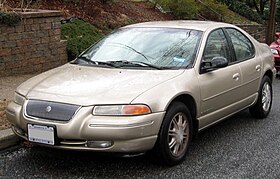Chrysler Cirrus
| Chrysler Cirrus | |
|---|---|
 |
|
| Overview | |
| Manufacturer | |
| Also called |
|
| Production | June 1994–2000 |
| Model years |
|
| Assembly | United States: Sterling Heights, Michigan (Sterling Heights Assembly) |
| Designer | Michael Santoro (1991) |
| Body and chassis | |
| Class | Intermediate |
| Body style | 4-door sedan |
| Layout | Transverse front-engine, front-wheel drive |
| Platform | Chrysler JA platform |
| Related | Chrysler Sebring convertible |
| Powertrain | |
| Engine | |
| Transmission |
|
| Dimensions | |
| Wheelbase | 108 in (2,743 mm) |
| Length | 186.0–186.7 in (4,724–4,742 mm) |
| Width | 71.0–71.7 in (1,803–1,821 mm) |
| Height | 54.1–54.4 in (1,374–1,382 mm) |
| Curb weight | 2,911–3,181 lb (1,320–1,443 kg) |
| Chronology | |
| Predecessor |
|
| Successor |
|
The Chrysler Cirrus and middle-priced variant Dodge Stratus are mid-size 4-door family sedans introduced for the 1995 model year. A third and lowest-priced variant, the Plymouth Breeze, arrived the following year. Production continued through the 2000 model year.
Employing the Chrysler JA platform, the sedans were known collectively as the "Cloud Cars" because their names referenced meteorological terms (cirrus, breeze, stratus).
Development of the Cirrus started in 1991, with the goal to create a car that was expressive looking and fun to drive, yet safe enough to transport an everyday family.
The concept show vehicle featured rear suicide doors and a 400 hp turbocharged 3.0-liter two stroke engine. Both the concept and production model used the Chrysler Corporation's new cab-forward design, which was launched on the larger LH sedans in 1992. Cab-forward design was characterized by the long, dramatically slanted windshield, and short overhangs. The wheels were pushed further to the corners of the vehicle, which created a much larger passenger cabin than most other similarly sized vehicles of that time.
The Cirrus was designed with flowing lines with no distinct beginning or end. This was done to eliminate the common three-box design, which was characterized by distinct breaks between the engine, passenger, and trunk compartments. Design work was done by famed Chrysler designer Michael Santoro during 1991, with the final design immediately being frozen for production by 1992. Design patents were filed on November 30, 1993 and granted on June 18, 1996.
It was often compared to other small mid-sizes such as the Chevrolet Malibu, and judged roomier than the Ford Contour by many magazines such as Consumer Reports. While the extended Ks had previously been Chrysler's main midsize offerings, the larger LH and LX platforms, conceived as replacements for the Chrysler Dynasty and Dodge Monaco, would more directly compete with the Ford Taurus, the upsized Honda Accord and Chevrolet Lumina.
...
Wikipedia
